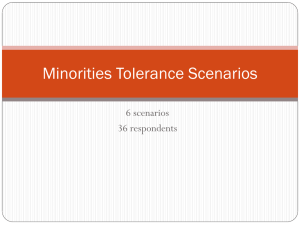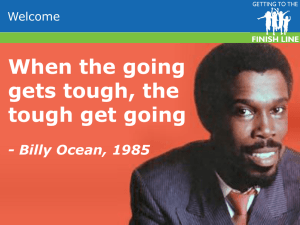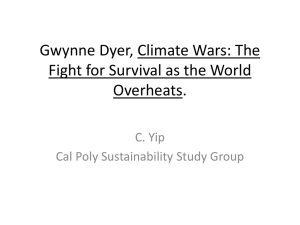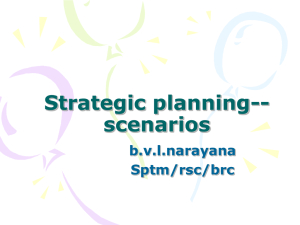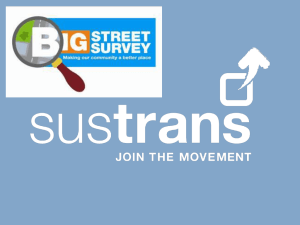DESIGNING FUTURE TRANSPORT SYSTEMS BY SCENARIO AND
advertisement
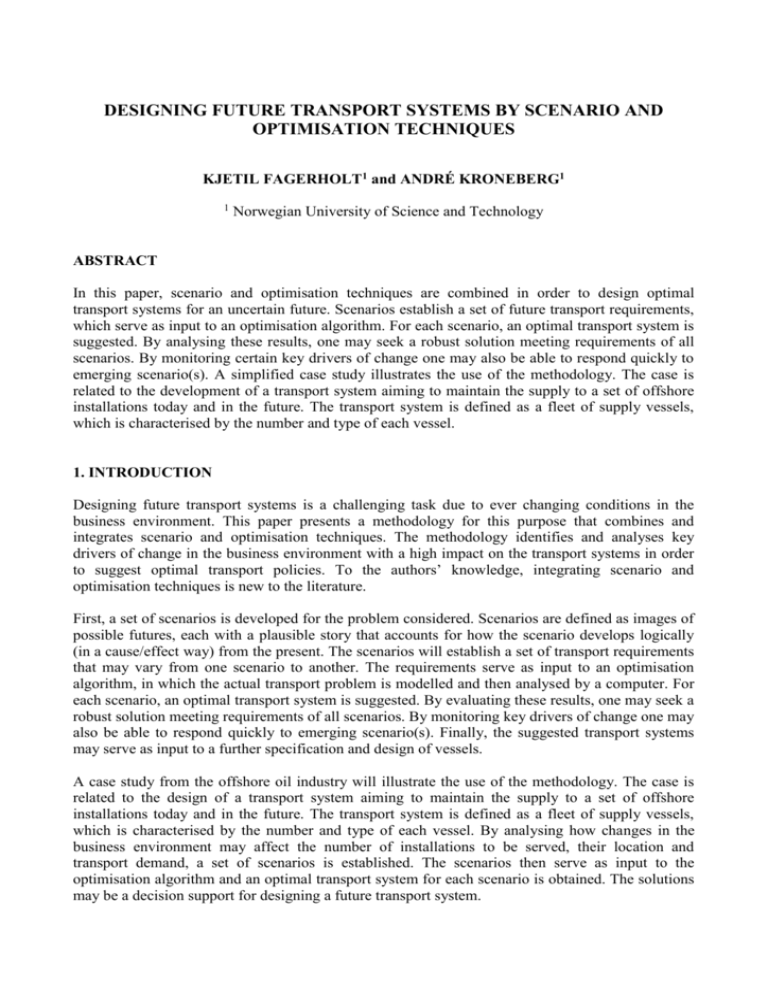
DESIGNING FUTURE TRANSPORT SYSTEMS BY SCENARIO AND
OPTIMISATION TECHNIQUES
KJETIL FAGERHOLT1 and ANDRÉ KRONEBERG1
1
Norwegian University of Science and Technology
ABSTRACT
In this paper, scenario and optimisation techniques are combined in order to design optimal
transport systems for an uncertain future. Scenarios establish a set of future transport requirements,
which serve as input to an optimisation algorithm. For each scenario, an optimal transport system is
suggested. By analysing these results, one may seek a robust solution meeting requirements of all
scenarios. By monitoring certain key drivers of change one may also be able to respond quickly to
emerging scenario(s). A simplified case study illustrates the use of the methodology. The case is
related to the development of a transport system aiming to maintain the supply to a set of offshore
installations today and in the future. The transport system is defined as a fleet of supply vessels,
which is characterised by the number and type of each vessel.
1. INTRODUCTION
Designing future transport systems is a challenging task due to ever changing conditions in the
business environment. This paper presents a methodology for this purpose that combines and
integrates scenario and optimisation techniques. The methodology identifies and analyses key
drivers of change in the business environment with a high impact on the transport systems in order
to suggest optimal transport policies. To the authors’ knowledge, integrating scenario and
optimisation techniques is new to the literature.
First, a set of scenarios is developed for the problem considered. Scenarios are defined as images of
possible futures, each with a plausible story that accounts for how the scenario develops logically
(in a cause/effect way) from the present. The scenarios will establish a set of transport requirements
that may vary from one scenario to another. The requirements serve as input to an optimisation
algorithm, in which the actual transport problem is modelled and then analysed by a computer. For
each scenario, an optimal transport system is suggested. By evaluating these results, one may seek a
robust solution meeting requirements of all scenarios. By monitoring key drivers of change one may
also be able to respond quickly to emerging scenario(s). Finally, the suggested transport systems
may serve as input to a further specification and design of vessels.
A case study from the offshore oil industry will illustrate the use of the methodology. The case is
related to the design of a transport system aiming to maintain the supply to a set of offshore
installations today and in the future. The transport system is defined as a fleet of supply vessels,
which is characterised by the number and type of each vessel. By analysing how changes in the
business environment may affect the number of installations to be served, their location and
transport demand, a set of scenarios is established. The scenarios then serve as input to the
optimisation algorithm and an optimal transport system for each scenario is obtained. The solutions
may be a decision support for designing a future transport system.
In chapter 2, a brief overview of both scenario and optimisation techniques is given, and the
advantages of integrating these techniques are discussed. Chapter 3 presents the use of the
methodology on the case study, while conclusions are given in chapter 4.
2. METHODOLOGY
This chapter provides a short introduction to scenario and optimisation techniques and potential
benefits from integrating these techniques.
2.1 Scenario Techniques
Scenarios are structurally different stories about how the future might develop. Scenarios are not
predictions, but rather descriptions of plausible futures. Scenarios reject traditional single point
forecasting techniques based on historical data, by making it possible to take into account structural
changes in the business environment causing the future to deviate radically from observable trends.
Scenarios emerged following World War II, as a method for military planning. The U.S. Air Force
tried to imagine what its opponents might do, and prepared alternative counter active strategies [1].
The theoretical and practical foundations for the use of scenarios in business were developed in the
1970s. The importance of using scenarios to address uncertainties in strategic planning was
dramatically underlined by the widespread confusion, which followed the oil price shock in 1973
[2].
Companies report a wide range of benefits from scenario planning ([3], [4] and [5]):
A broader framework for strategic planning. Scenarios help to avoid blind-spots that result from
considering isolated trends, solely quantifiable information and purely economic data.
Consistent frameworks and language for discussing critical future issues throughout the
business.
New ways of thinking about and planning for the future (exploratory studies).
More robust and flexible strategies through the use of scenarios as a test-bed for evaluation of
strategies.
Identification of major uncertainties so that companies can develop and direct appropriate
business-environment scanning and monitoring efforts.
For an introduction to the broad spectrum of various scenario techniques, see for example [6], [7]
and [8]. The techniques are mainly of a qualitative and intuitive nature, thus resulting in “storybased” scenarios. The strategic consequences of stories may sometimes be hard to concretise and
quantify (e.g. “How many vessels, of what capacity and speed should be bought or chartered if this
scenario should occur?”). A lack of clear understanding of strategic consequences derived by
scenarios is a potential obstacle for fully realising the benefits from using scenario techniques.
2.2 Optimisation Techniques
A general formulation of a mathematical optimisation problem can be stated as:
min f(x) ,
(1)
Subject to x X .
(2)
Here, f is an objective function to be minimised, while x is a vector of variables or decisions. X is
the solution space for the vector x, defined by the problem constraints. Various techniques exist to
solve optimisation problems defined as in (1) – (2). Examples of such techniques are linear/integer
programming, dynamic programming and specialised network algorithms, see for instance [9].
Combinations of these techniques may also be applied to solve optimisation problems. Rule-based
search techniques may also be a good approach, especially for combinatorial problems where it is
hard to find the supreme optimum, see for instance [10].
It is hard to discuss the applicability of optimisation techniques on a general basis, due to the variety
of these techniques. However, there are (at least) two common characteristics for these techniques.
First, one has to make a model of the real problem considered. The optimal solution of a model is
however not an optimal solution of a problem unless the model is a perfect representation of the
problem, which it never is [11]. When it comes to modelling the real problem, there is often a tradeoff between detail level of the model and the ability to solve it. One often has to make
simplifications to be able to construct models that can be solved.
Second, most optimisation techniques do not handle uncertainty and stochastic elements in an
explicit way. However, in the last decade or so there has been some research effort in developing
optimisation techniques for stochastic problems, see for instance [12]. Still, most practical
stochastic problems are really hard to solve by optimisation techniques and one may also often
question how well the stochastic models succeed in reflecting the uncertainty of the real problem.
Despite this, there are numerous examples of successful applications of optimisation techniques. In
problems where the solution space is large, it may often be a good help to let an optimisation
routine implemented on a computer search through the solution space. The solutions from an
optimisation algorithm may also be a valuable support in understanding strategic consequences of
various decisions. In a study of determining optimal routing policies for supply vessels in the oil
industry by Fagerholt and Lindstad [13], an optimisation method was applied to evaluate the effect
of various decisions. Based on this, the Oil Company changed their fleet of supply vessels, and
experienced annual savings of several million dollars.
2.3 Integrating Scenario and Optimisation Techniques
Realising that scenario and optimisation techniques may complement each other, a number of
desired benefits might be realised by combining the two.
Optimisation techniques do not handle uncertainty in a satisfactorily way, but “story-based”
scenario techniques describe possible structural changes that may cause the future to deviate
radically from observable trends. These scenario techniques do not give a complete understanding
of strategic consequences, but optimisation techniques will reveal quantifiable consequences of
scenario assumptions.
To the authors’ knowledge, integrating scenario and optimisation techniques is new to the literature.
However, simulation techniques have successfully been applied in scenario planning in order to
calculate variables such as revenue, cost, profit and market share over a number of business cycles.
Computer simulations also allow for exploration of how key drivers of change interact over time
and their resulting strategic implications. For practical suggestions on how to integrate simulation
with scenario planning see [14].
3. CASE STUDY
In this chapter, a case study demonstrates how scenario and optimisation techniques may be
integrated.
3.1 Problem Description
Today, oil companies are operating a number of various offshore installations around the world.
Crucial for an efficient operation is that regular supplies of various commodities (e.g. food, mud,
brine, diesel and water) are maintained. Offshore installations are normally served from onshore
depots by supply vessels.
In this simplified case, we imagine three offshore installations presently being served from one
onshore depot, as illustrated in Figure 1. The task is to design an optimal transport system for
serving offshore installations today and in the future. The transport system is defined as a set of
supply vessels, which is characterised by the number and type of vessels. In the future, the structure
of installations (number, location and demand) depends upon changes in the business environment,
which again may influence the need for transport demand. We assume for simplicity that there are
only two vessel sizes and two vessel speeds that can be selected. This gives a total of four vessel
types: Small/slow, small/fast, large/slow and large/fast. Each vessel type has a given time charter
cost.
Onshore depot
Offshore depot, size indicates supply demand
Figure 1: Onshore depot and offshore installations, today
3.2 Development of Scenarios
In order to develop the scenarios, a scenario technique developed by Stanford Research Institute
(SRI) Consulting is applied (refer Figure 2). SRI Consulting has used scenario based techniques in a
wide range of studies of the future since the mid 1960s.
Step 1
Strategic
Decisions
Step 2
Key Decision
Factors
Step 4
Step 3
External Forces
Scenario Logics
Decision
Implications
Step 6
Scenarios
Step 5
Figure 2: Scenario Technique developed by SRI Consulting [4]
The methodology includes six steps that a multidisciplinary team should perform in a series of
workshops. In this case study, however, the purpose is merely to demonstrate benefits from
integrating scenario and optimisation techniques. A full-blown scenario process has therefore not
been undertaken. A simplified approach was chosen. The authors worked out a set of scenarios in a
one-day workshop based on their experience from earlier projects in offshore logistics.
In the following, the results from the one-day workshop are presented by following the six steps in
the scenario technique as presented in Figure 2.
The process starts out by identifying the strategic decisions the scenarios should answer. The
strategic decision will focus and constrain the subsequent steps in the process. In this case, the
strategic decisions were stated as:
Design an optimal transport system for serving a set of offshore installations today and in the
future. The transport system is defined as a set of supply vessels, characterised by the number and
type of each vessel.
In the second step, a set of key decision factors is identified. Key decision factors are the matters
that the decision-makers want more information about, because if this information were available it
would enable them to make better decisions. In order to choose an optimal transport system for
serving future offshore installations, the authors would like to know more about:
Client structure – number, location and demand of existing and future installations
The third step seeks to identify external forces that influence the value of the key decision factors. It
may be helpful to structure the thinking around micro forces and macro forces. Micro forces may be
analysed according to Porter’s five competitive forces (competitors, suppliers, buyers, potential
entrants, and substitutes) [15]. The macro forces may be analysed by the help of the SEPT scheme in which external forces are organised in terms of Social, Economic, Political and Technological
factors [5]. Normally, 80-100 external forces are identified.
In the fourth step, the forces are analysed in terms of their relative uncertainty and impact on the
key decision factors. The key uncertainties confronting the strategic decision - and the sources of
difference among the scenarios - lie in the forces grouped in the “high impact/high uncertainty area”
[3]. By analysing and clustering “high impact/high uncertainty” forces, key drivers of change are
identified and a structure for the scenarios is developed. For the case study, two key drivers of
change were established:
1. The Oil Price. A key driver with a high impact on the level of exploration activities.
2. Technology Development. A key driver influencing the type of new installations to be
developed (e.g. sub-sea and floating production).
In selecting the key drivers, we were trying to identify drivers with a high level of independence, in
order to achieve structurally different scenarios. Each key driver was assigned two extreme, but
plausible, levels of occurrence. In this way, the extreme points of plausible futures could be
embraced. Based on the two key drivers a scenario logic was established as shown in Figure 3.
Revolution
Scenario 1:
“Deep Water Day”
High
Scenario 3:
“Floating Clients”
Scenario 2:
“Bottom Line”
Low
Evolution
Technology
Development
Oil Price
Scenario 4:
“Sub-sea King”
Figure 3: The scenario logic
In Table 1, a short summary (step 5) of the scenarios is given together with their strategic
implications (step 6) for the key decision factors (step 2) and the strategic decisions (step 1).
Table 1: Four scenarios
Scenario 1 “Deep Water Day”
(High Oil Price, Revolutionary Technology)
The scenario is characterised by:
A stable high oil price
Strengthened exploration activities
Breakthroughs in deep water technology enabling
exploitation of deep water oil fields
Likely strategic implications are:
Development of two major deep water fields with
high supply demands, located farther away from
shore than existing fields
Continuation of production in existing fields
Scenario 2 “Bottom Line”
(Low Oil Price, Revolutionary Technology)
The scenario is characterised by:
The oil price resides in a low level
Reduced exploration activities
The low oil price triggers a breakthrough in
technologies for separation of oil, allowing for subsea production and processing with direct transfer of
oil to shore by pipelines
Likely strategic implications are:
Close-down of existing fields, due to low oil price
Only minor needs for supply services in order to
develop sub-sea installations and infrastructure
Sub-sea
infrastructure
Scenario 3 “Floating Clients”
Scenario 4 “Sub-sea King”
(High Oil Price, Evolutionary Technology)
(Low Oil Price, Evolutionary Technology)
The scenario is characterised by:
A high oil price ensured by strong self discipline
among OPEC members
Strengthened exploration activities
Floating production technology improves as
experience from operation is gained
Likely strategic implications are:
Continuation of production in existing fields
Oil production in a number of smaller new fields by
floating production vessels results in increased
supply demand
The scenario is characterised by:
A steady reduction in the oil price
Reduced exploration activities
Further development of today’s sub-sea technology
for improving the utilisation of existing fields
Likely strategic implications are:
No new installations
Continuation of production in existing fields
Sub-sea production connected to the existing
infrastructure results in slightly increased demand
for supply services
3.3 Designing optimal solutions
An optimisation algorithm is developed to determine the optimal fleet of supply vessels for each
scenario. However, to determine an optimal fleet, one must also consider the coherent routing
policy for the fleet, since the routing influences the optimality of the fleet and vice versa. The
algorithm used to determine the optimal fleet therefore also simultaneously calculates the coherent
routes for each vessel selected to be in the fleet (although the determination of the routes is not an
essential task in this matter). The routes to be performed by the vessels are repetitive with given
time intervals. For instance, one may determine routes that are to be repeated with a cycle of one
week.
Since a vessel may perform several routes during the cyclic time interval, the underlying routing
problem can be considered to be a multi-trip Vehicle Routing Problem (VRP). The classical singletrip VRP is a hard and well-known combinatorial optimisation problem which calls for the
determination of the optimal routes for a fleet of vehicles with given capacities, based at a depot,
serving a set of customers with given demands. For details on the VRP, see for instance the survey
of Toth and Vigo [16]. For the single-trip VRP, it is assumed that each vehicle performs only one
trip during the planning period, while this is relaxed in the multi-trip VRP. The multi-trip VRP is
studied in [17] and [18].
Determining an optimal fleet together with the coherent routes in a multi-trip VRP has received
little attention. A problem having some similarities to the case studied here is given in [19].
However, the solution algorithm developed there requires all vessels to have the same service
speed. Fagerholt and Lindstad consider a problem similar to the one presented here, and their
solution algorithm allows the vessels to have various speeds [13]. A simplified version of their
solution algorithm is used to determine the optimal fleet for each scenario and is described in the
following. For details of the solution algorithm, see [13].
The proposed optimisation algorithm works in two phases and combines the use of dynamic and
integer programming. By going through the two-phase algorithm for each of the four scenarios, an
optimal fleet is suggested for each scenario. Variations of this solution approach have frequently
been applied in determining optimal routes for a given fleet, see for instance [20] and [21].
In phase 1, all feasible routes for each of the four vessel types are generated. This is done by
systematically working through all possible subsets of offshore installations. For each subset, we
check if the selected vessel type has enough capacity compared with the given demand at the
installations in the subset. If so, the optimal roundtrip is determined by solving a Travelling
Salesman Problem (TSP), which may for instance be done by dynamic programming.
In the second phase, the vessel types to be used and their coherent routes are determined by solving
an integer programming model, in which the columns represent the vessel routes generated in phase
1. The integer programming model will be described as follows:
Sets
K
N
Rk
Vessels in the pool, indexed by k.
Offshore installations, indexed by i.
Schedules for ship k (generated in phase 1), indexed by r.
Parameters
Trk
Airk
TMAX
Si
Ck
M
Variables
k
x rk
The duration in hours of schedule r for ship k (calculated in phase 1).
Constant that is equal to 1 if vessel k services installation i on schedule r and 0
otherwise (derived in phase 1).
Length of cycle period.
Minimum number of services for installation i during the period TMAX .
Cost of using supply vessel k.
Large number.
Binary variable that is equal to 1 if vessel k is used in the optimal solution and 0
otherwise.
Integer variable indicating the number of times per week ship k sails its schedule r.
The integer programming model of phase 2 in the solution algorithm can now be formulated:
min
C
k
k
(3)
,
kK
A x
i N ,
(4)
xrk TMAX ,
k K ,
(5)
M k 0 ,
k K ,
(6)
x rk integer,
k K , r Rk ,
(7)
k {0,1} ,
k K .
(8)
k K r Rk
T
rRk
k
r
x
r Rk
k
r
k
ir
k
r
Si ,
(3) is the objective function and ensures the minimisation of the total cost of using the vessels. The
main cost component is the TC-cost, which also reflects the capital costs if the vessels are owned.
Constraints (4) ensure that each offshore installation is served at least the minimum number of
times during the cyclic period, which can for instance be one week. This requirement may vary
between the four scenarios. Constraints (5) ensure that the sum of the total time of the schedules for
a given vessel does not exceed the length of the cyclic period. Then, we determine routes that are
repeated every period. Coupling constraints (6) ensure that if at least one route is selected, then the
corresponding binary variable for that vessel must be equal to one. (7) and (8) impose integer and
binary restrictions on the variables, respectively.
To ensure that several vessels of each type can be selected, one may duplicate the columns for each
vessel type before solving the integer programming model given by (3) - (8). The model can now be
solved by commercial integer programming software.
By going through the generation of routes (phase 1) and the solution of the integer programming
model (phase 2), we can determine an optimal fleet and the vessel routes for each of the four
scenarios. Since there are significant variations in the demand and the locations of the oil and gas
installations between the scenarios, the solutions will also differ. Table 2 shows what the optimal
fleet for the four scenarios can be for the simplified case study.
Table 2: Model solutions
Scenario
1
Name
Optimal solution
Deep Water Day
2 large/fast and 1 small/slow vessels
Scenario 1 involves two new major deep water
installations. Since sailing times compared to
service times are higher for the deep water
installations than for existing installations, it is
optimal to introduce two high speed vessels
serving the deep water installations. The small
slow speed vessel and some surplus capacity of
the two high speed vessels serve the existing
installations.
2
Bottom Line
Sub-sea
infrastructure
3
Floating Clients
1 small/slow vessel
Scenario 2 involves a drastic reduction in the
demand of supply services and the optimal
solution involves only one small slow speed
vessel.
2 small/slow and 1 large/slow vessels
Scenario 3 involves increased demand for
supply services due to oil production in some
new smaller fields. The optimal solution
involves two small slow speed vessels and one
large slow speed vessel, which together serve all
fields.
4
Sub-sea King
1 large/slow and 1 small/slow vessels
Scenario 4 gives a slight increase in transport
demand due to increased production in existing
fields. The optimal solution involves one large
slow speed vessel and one small slow speed
vessel, which together serve the fields.
3.4 Discussion of Solutions
Before deciding on an optimal transport system for the future, one should address the time horizon
of the scenarios and the time required for implementing the optimal transport solution.
Generally, scenarios are developed for time horizons ranging from five to twenty years, with an
emphasis on five to ten years. However, whether a certain change in the business environment
occurs in three, five or seven years is difficult to say and of less importance. What is important is to
understand how the key drivers of change may shape the future, what implications may be expected
and in what time. In this way a common mental framework for the future might be developed. By
“rehearsing the future”, a company may be able to react to changes faster than its competitors. In
the case study, a high oil price and major technological breakthroughs in deep-water technology
may trigger a decision to develop two major deep-water fields. The time from the decision to
develop the installations until the installations are in operation may take several years. However, if
developments in offshore technology are of a more evolutionary kind, and the oil price rises,
increased interest in floating production may be expected. Depending on the market for floating
production vessels, oil production in a number of smaller fields may start in a relatively short time
period.
The time required for implementing the optimal transport system may vary from a couple of weeks
to several years. If the charter market has surplus capacity, a new supply vessel may be chartered
and made ready for operation in a couple of weeks. However, if there are no suitable vessels
available, a new vessel may have to be built. A new-building process may take up to several years
depending on the degree of innovation in the design. Scenario and optimisation techniques may also
reveal a future need for vessels not available in the market today, for example supply vessels with a
speed exceeding 25 knots. If this is the case, one may prepare for such requirements by developing
relations to innovative yards and designers.
Based on the discussion above, it is obvious that a monitoring system should be established in order
to track the migration towards emerging scenario(s). Key drivers of change that have been
identified in the scenario process point to key indicators for monitoring. By monitoring these
indicators, one may initiate necessary actions at an early stage in order to establish a new optimal
transport system meeting new needs.
It is also possible to identify a robust strategy for the transport system. A robust strategy may be to
own a small slow speed vessel, and charter additional vessels on short-term contracts. The reason
for owning a small slow speed vessel is that all scenarios require such a vessel. By chartering
additional vessels on short-term contracts, flexibility for adapting to emerging scenarios is gained.
A robust strategy combined with a monitoring system may be the best solution for this case study.
4. CONCLUSIONS
This paper describes the design of future transport systems by combining and integrating scenario
and optimisation techniques. These two techniques complement each other. Optimisation
techniques do not handle uncertainty in a satisfactorily way, but scenario techniques do. Scenario
techniques do not give a sufficient basis for strategic decisions, (i.e. quantifiable) but optimisation
may contribute in this respect.
The methodology has been illustrated on a simplified case from the oil industry, related to the
development of a transport system aiming to maintain the supply services to a set of offshore
installations today and in the future. By analysing key drivers of change (e.g. the oil price and
development in offshore technology), four scenarios are established, each describing a plausible
future. By using optimisation techniques, an optimal fleet of supply vessels for each scenario is
suggested. The scenario specific solutions are discussed according to robust elements and how
monitoring of key drivers of change may assist in choosing the best solution.
It would be appropriate to perform sensitivity analysis in order to evaluate the robustness of the
optimal solutions. This can be done by running several optimisations for each scenario. For each
run, we could for instance adjust the demand levels at the oil fields. Another way to evaluate the
robustness of an optimal solution is to model the problem by a simulation tool and run simulations.
REFERENCES
1. Schwartz, P. (1991), The Art of the Long View, Doubleday, New York.
2. Mercer, D. (1995), Scenarios Made Easy, Long Range Planning, Vol. 28(4), pp. 81-86.
3. Zaman, P.A. and Wilson, I.H. (1991), Scenario Planning in Telecommunications: A DecisionFocused Approach, SRI International, Business Intelligence Program, Report No. D91-1507,
Menlo Park.
4. Mandel, T.F. and Wilson, I.H. (1993), How Companies Use Scenarios: Practices and
Perception, SRI International, Business Intelligence Program, Report No. 822, Menlo Park.
5. Mandel, T.F. (1993), Scenarios and Corporate Strategy: Planning in Uncertain Times, SRI
International, Business Intelligence Program, Report No. 669, Menlo Park.
6. Van Der Heijden, K. (1996), Scenarios: The Art of Strategic Conversation, John Wiley & Sons.
7. Fahey, L. and Randall, R.M. (Eds.) (1997), Learning from the Future: Competitive Foresight
Scenarios, John Wiley & Sons.
8. Ringland G. (1998), Scenario Planning: Managing for the Future, John Wiley & Sons.
9. Ravindran, A., Phillips, D.T. and Solberg, J.J. (1987), Operations research. Principles and
practice (second edition), John Wiley & Sons Ltd, Canada.
10. Reeves, C.R. (Eds.) (1995), Modern Heuristic Techniques for Combinatorial Problems,
McGraw-Hill International Ltd, UK.
11. Ackoff, R.L. (1979), The future of Operational Research is past, Journal of the Operational
Society, Vol. 30(2), pp. 93-104.
12. Kall, P. and Wallace, S.W. (1994), Stochastic programming, John Wiley & Sons Ltd, England.
13. Fagerholt, K. and Lindstad, H. (1999), Optimal policies for maintaining a supply service in the
Norwegian Sea, To appear in OMEGA The International Journal of Management Science.
14. Paich, M. and Hinton, R. (1997), Industry Scenarios. In Learning from the Future: Competitive
Foresight Scenarios, pp. 22-38, Fahey L. and Randall R.M. (Eds.), John Wiley & Sons.
15. Porter, M.E. (1980), Competitive Strategy – Techniques for Analyzing Industries and
Competitors, New York.
16. Toth, P. and Vigo, D. (1998), Exact solution of the vehicle routing problem. In Fleet
management and logistics, pp. 1-31, Crainic, T.G. and Laporte, G. (Eds.), Kluwer Academic
Publishers.
17. Taillard, E.D., Laporte, G. and Gendreau, M. (1996), Vehicle routeing with multiple use of the
vehicles, Journal of the Operational Research Society, Vol. 47, pp. 1065-1070.
18. Brandão, J. and Mercer, A. (1997), A tabu search algorithm for the multi-trip vehicle routing
and scheduling problem, European Journal of Operational Research, Vol. 100, pp. 180-191.
19. Fagerholt, K. (1999), Optimal fleet design in a ship routing problem, International Transactions
in Operational Research, Vol. 6(5), pp. 453-464.
20. Brown, G.G., Graves, G.W. and Ronen, D. (1987), Scheduling ocean transportation of crude oil,
Management Science, Vol. 33(3), pp. 335-346.
21. Bausch, D.O., Brown, G.G. and Ronen, D. (1998), Scheduling short-term marine transport of
bulk products, Maritime Policy and Management, Vol. 25(4), pp. 335-348.
